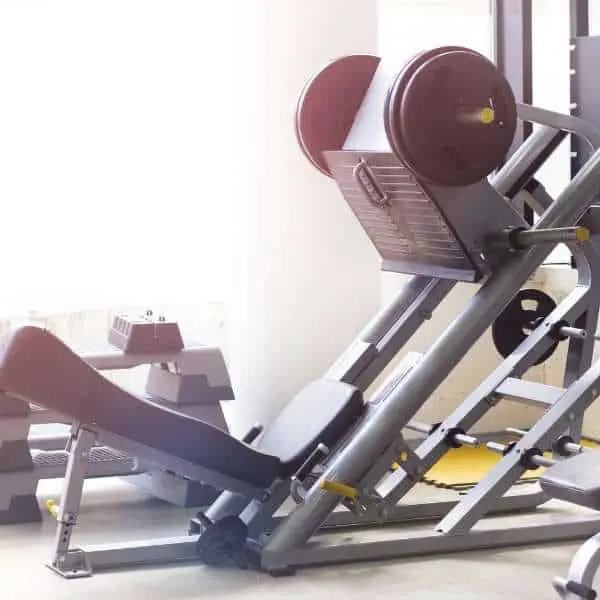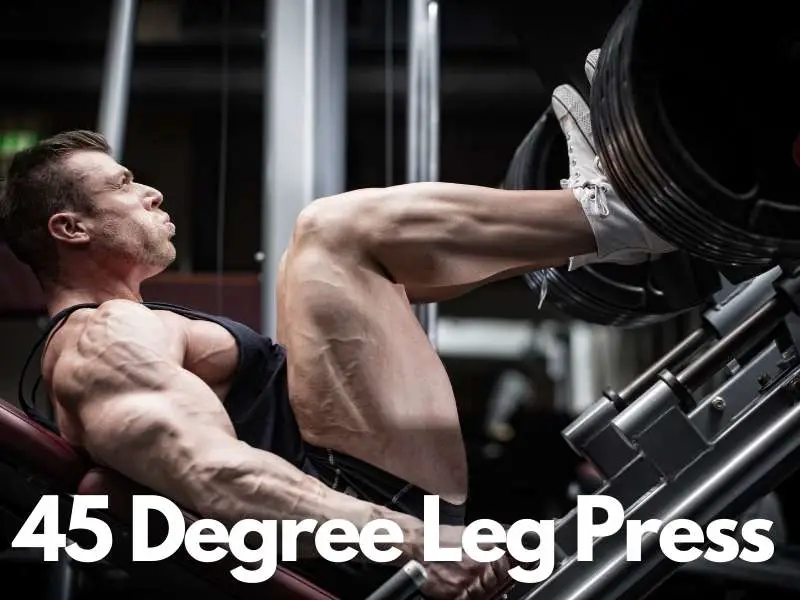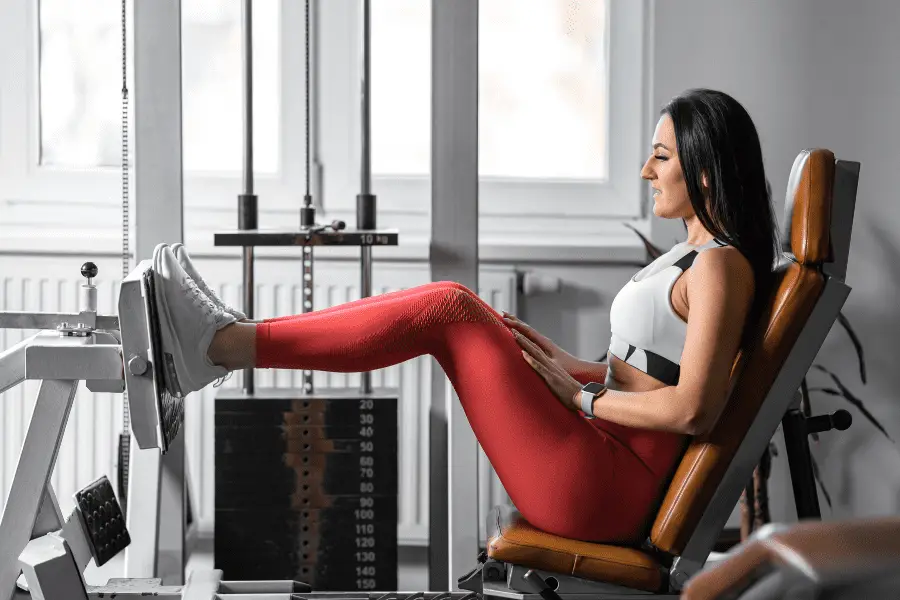You might have noticed there are a few different types of leg press machines. Some gyms have a few different types. What is the difference between the types and does it actually matter? Let’s find out.
There are three main types of leg press:
These types refer to the direction in which you push the weight. The movement pattern is very similar between all those types but there are differences in Size, price, and comfort as well as small differences in the movement pattern.
Below we’ll go into the different types of leg press machines and what the differences are.
Contents
Types of leg press machine
There are a few different types of leg press machines. As already mentioned above, there are three main types. However, there is another way leg press machines differ we should also look at.
There are two ways leg press machines are different:
Below you can find exactly how leg press machines differ in those ways and what difference they make.

Pushing Direction
The most obvious difference between different leg press machines you can see in an instant is the seating position. The way you sit and push on the leg press can differ quite a bit from model to model but there are three main types you can distinguish between:
Let’s take a look at the different seating positions.
Suggested: How big is a leg press machine
Upright/horizontal/seated leg press

This is the most common type of leg press machine you’ll see in large gyms and health clubs. You have a seat with a backrest that is in the normal upright position just like a chair. This makes this type of machine really easy to get on and off, especially compared to the types we’ll discuss below.
The foot plate is vertically (or almost vertically) in front of the seat. You raise up your legs and place them on the footplate.
From here there are actually two more types:
The first type has the seat on a set of inclined rails which are angled up. The foot place stays in the same place. The resistance is connected to the seat. This type tends to be a bit smaller and cheaper than the second type. Since the seat moves, you’re also pushing your body weight. This can make tracking your resistance levels difficult when losing or gaining weight.
The second type the seat stays in place but you push the footplate away. This type can have a slightly more natural movement pattern because the footplate doesn’t quite move straight back and forth. This makes these machines larger and more complicated which in turn makes them more expensive. The slightly different movement pattern is easier on the joints. Combine that with a seat that’s very easy to get on and you have a machine that’s suitable for most people in most gyms.
45 Degree leg press

The second type is another one that’s common in many gyms, usually the more muscle-building focused gyms. On this type, there are two rails that are at a 45-degree angle (on some models the angle varies slightly). The place you sit is actually under the footplate. So when you lay down, your back is almost horizontal to the floor. You load the weights on the sled and push the sled away.
This type of machine is more difficult to get on and off and for less mobile people it can be a problem. It also feels a bit more intimidating since you’re under the weights.
The 45-degree leg press is virtually always plate-loaded and can handle very high loads. That’s why it’s a popular choice in gyms where people want to lift heavy weights to build a lot of muscle and strength. Since they’re not limited by the weight stack, you can go up to 1000 lbs. or even more on some models. As long as you’ve got enough weight plates, you can keep stacking them on.
I find that 45-degree leg press machines often feel the smoothest and most natural. Usually, the range of motion on these is also a bit longer which means you can go deeper without hitting the stops on the machine. This extra range of motion helps build more muscle if used properly.
Check out the PowerTec Plate loaded 45-degree leg press on Amazon. It’s relatively affordable and can handle up to 1000 lbs.
Vertical leg press
Vertical Leg Press
Finally, there is the vertical leg press. The ‘vertical’ in the name refers to the direction the weight moves in. You push the weight straight up and down on this machine. Imagine a 45-degree leg press but tilted until the slide rails are vertical. That’s the seating position you’ll be in. So your back will actually be at a slight decline, and your head is a little lower than your hips.
There is often no large footplate, just a little bar you push against. This type of machine is difficult to get on and off because you basically lay flat on the floor. There is a backrest to make it more comfortable but for less mobile people, this is probably not a good choice. Vertical leg presses also tend to have much lower load limits than the 45-degree version. A 400 lbs. load limit is common, which is actually similar to the resistance you get on stack-loaded horizontal leg press machines. There are some options that can handle up to 800 lbs. though.
The benefit of this type is that it’s a lot smaller and cheaper than the other two types of leg press mentioned above. That means it’s a much more accessible option for a home gym. A vertical leg press can cost less than half of a 45-degree leg press machine although there are huge price differences between models of all types.
Leg Press Machines Load Type
The second way leg press machines differ is the load type. There are two ways to add resistance to a leg press:
Let’s look at the differences between the two.

Selectorized Machines
A weight stack is a common way to provide resistance for many gym machines and a leg press is no different. There is a stack of weights that is connected to the footplate (or seat, whichever moves). The stack is connected with a cable through a system of pulleys. You can pick the amount of resistance you want by putting a pin in the weight plate you want.
This is a really easy and tidy way to load any machine. All the weights are contained within the machine and it’s very easy to change the resistance by just moving a pin. You can often do this without even leaving your seat.
Virtually all selectorized leg press machines are of the horizontal type.
Plate loaded Leg Presses
The other type to add resistance to a leg press is with weight plates. These machines have pegs to put plates on, simply put on as many as you need. There are load limits for machines that are plate-loaded so make sure to adhere to those limits.
Plate-loaded machines tend to be a bit cheaper since the weights are not included in the price. That doesn’t mean these machines are lower quality. They can be but there are also very high-quality plate-loaded leg presses.
If you’ve already got a set of weight plates and you’re willing to move them around to load onto different equipment, it’s a good way to save some money. Another benefit is that these plate-loaded machines often (not always) have a higher load limit than machines with a weight stack. So if you want to leg press very heavily, a plate-loaded machine is a better choice.
Of course, you do need enough weight plates to be able to get that amount of resistance. Weight plates themselves aren’t cheap either so you’ll have to figure out for yourself what’s better and/or cheaper for you.
Almost all 45-degree and vertical leg press machines are plate-loaded.
Differences between types of leg press machine
All the different types of machines do the same thing in the end. The back of the hips is supported on a back pad and you push a weight away from you. The movement pattern is quite similar with all the different types. There are minor differences with some of the seated leg press machines that make the movement pattern slightly less linear and more natural.
The seating position doesn’t change the movement pattern. It can feel different though. If only because your legs are less or more in the air which can cause a slightly different feel. The differences in getting on and off the machines are likely much bigger though. An upright machine is by far the easiest but also tends to be the biggest and most expensive. The vertical leg press is the smallest and most difficult with the 45-degree types somewhere in between.
